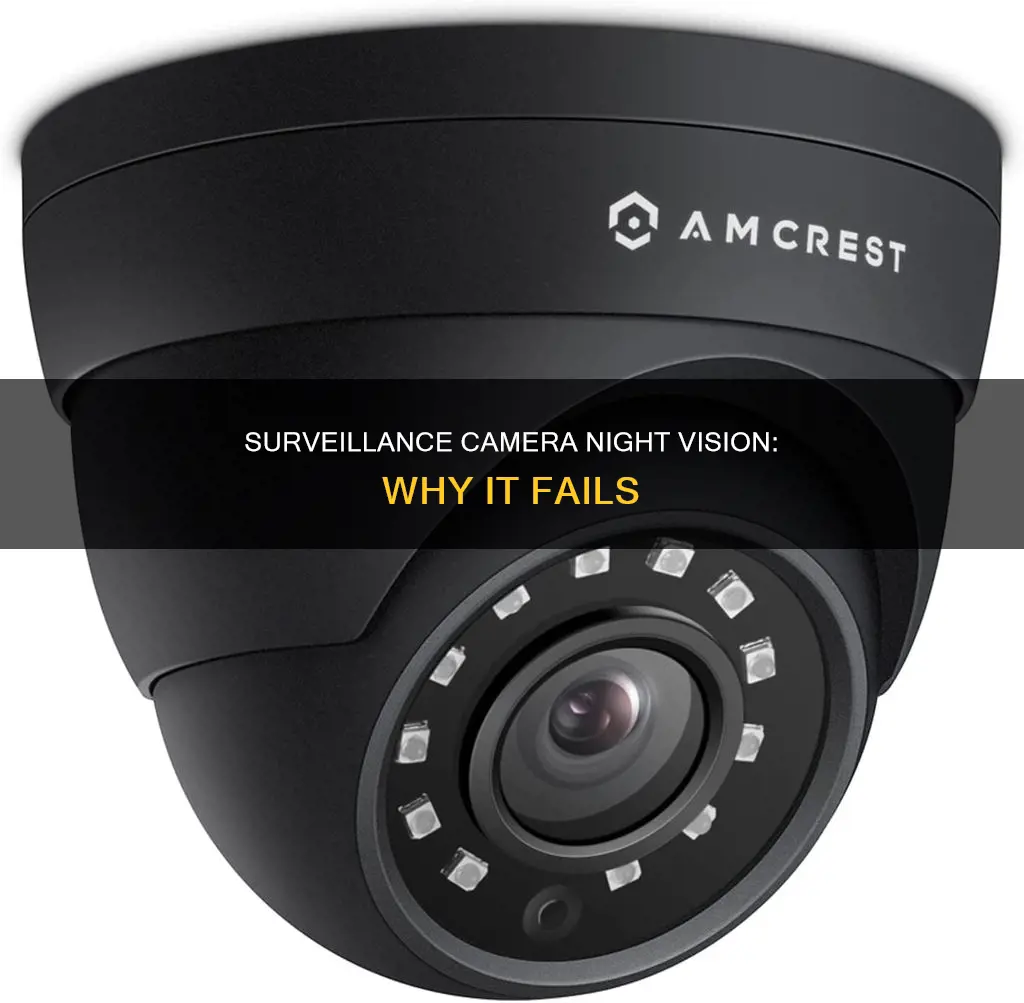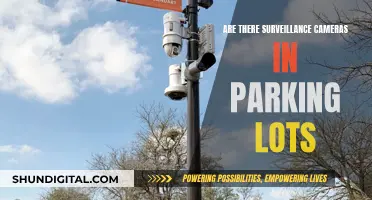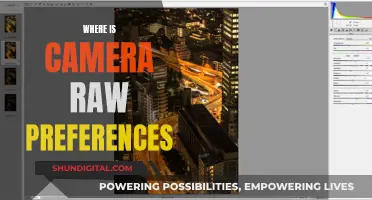
There are many reasons why your surveillance camera might shut off at night, and it can be frustrating to troubleshoot. The most common issues are related to power supply, network connection, hardware, and camera software. An inadequate power supply can cause a camera to shut off, so check your power connections and adapters. Network issues can also be a problem, especially if your camera relies on a wired or wireless connection. Check your Ethernet cables and Wi-Fi signal strength. Hardware issues, such as faulty wiring or monitor failure, may also be the culprit. Finally, inefficient camera software can cause problems; updating the software may resolve this.
| Characteristics | Values |
|---|---|
| Inadequate power supply | Loose cable connection, faulty power cables, PoE switch or PoE injector issues, cable too long or supplying too many cameras |
| Power spike and interference | Mounting camera to a metal/conductive surface, lightning strikes, strong electrical currents from nearby equipment |
| Weak WiFi connection or low bandwidth | Long distance between camera and router, too many barriers, WiFi signal interruption and interference, insufficient bandwidth, loose connections |
| IR cut filter and faulty IR night vision | Lack of infrared night vision, faulty IR sensor, IR not turned on |
| Signal type and compatibility | DVR or NVR unable to decode video stream, camera resolution too high for NVR/DVR |
| Problems in cables or wires | Twisted or bent cables, cable damage, wiring-related glitches |
| Hardware and firmware problems | Old or bug-ridden firmware, hardware failure |
| IP address conflicts | Same IP address used by another device on the network |
What You'll Learn

Insufficient power supply
If your surveillance camera shuts off at night, it could be due to an insufficient power supply. This can be caused by a variety of factors, including:
- Loose cable connections: Check all power connections, cable connectors, and power splitters to ensure they are secure and not damaged.
- PoE switch or PoE injector not working: Ensure that the PoE switch or injector is functioning correctly and providing sufficient power to the camera. If necessary, connect the camera directly to the NVR instead of using a PoE switch, as PTZ cameras and IR cameras require more electricity.
- Cable is too long or supplying too many cameras: Try using shorter BNC or Ethernet cables to power the cameras, and avoid using low-quality extension cords or cables.
- Faulty power cables: Inspect the power cables for any signs of damage, degradation, or cuts. If the cables are old or damaged, they may need to be replaced.
If you are experiencing issues with your surveillance camera shutting off at night due to insufficient power supply, here are some steps you can take to troubleshoot the problem:
- Check the power connection: Verify that the power supply is working correctly by testing other connected devices. Ensure that the power cable connected to the camera is securely plugged in at both ends.
- Inspect the power cable: Look for any visible signs of damage or wear on the cable. If the cable appears to be damaged, try replacing it with a new one.
- Try a different power outlet: Plug the camera into a different outlet to rule out any issues with the current outlet.
- Verify the power supply voltage: Refer to the camera's manual to check the required voltage range. Ensure that your power supply meets these specifications.
- Use a dedicated circuit: If multiple devices are connected to the same circuit, it may be drawing too much power. Consider using a dedicated circuit solely for your security camera.
- Test alternative power sources: Try connecting the camera to a different outlet or using an alternative power adapter to determine if the issue lies with the current power source.
- Upgrade wiring or add more outlets: If your building has old wiring, consider upgrading to ensure stable and reliable power delivery. Installing additional outlets can help distribute the power load more efficiently.
- Consider a UPS (Uninterruptible Power Supply): A UPS acts as a backup power source during outages and can regulate electricity flow, providing stable power to your camera.
Surveillance Cameras in Homes: How Common Are They?
You may want to see also

Power spike and interference
Power spikes and interference can cause sudden video loss on security cameras, resulting in a black screen, a camera with an electrified surface, or even serious damage to the camera's circuit board and other components.
Common Causes of Power Spikes and Interference
- Mounting a security camera on a metal/conductive surface
- Lightning strikes
- Strong electrical currents from nearby electrical equipment
How to Prevent Power Spikes and Interference
- Use power surge protectors or lightning surge protectors to safeguard your CCTV cameras from lightning strikes.
- Install UPS (Uninterruptible Power Supplies) units to ensure a continuous power supply to all cameras during a power outage, preventing camera shutdowns.
- If you must mount your camera on a metal or conductive surface, place a wooden block between the camera and the surface.
Ronin S Camera Focus: Mastering the Art of Stabilization
You may want to see also

Weak WiFi connection
A weak WiFi connection can cause your surveillance camera to shut off at night. Here are some reasons why this might be happening:
- Distance and Physical Barriers: The distance between your camera and router can impact the strength of the WiFi signal. If your camera is too far away from the router, the signal may not be strong enough to maintain a stable connection. Similarly, physical barriers such as walls, trees, or other building materials can block or weaken the WiFi signal.
- Interference: Interference from other devices or networks can disrupt the WiFi connection to your camera. This includes interference from co-channels, such as Bluetooth devices, radio frequencies, microwaves, and smartphones, which often use the same 2.4 GHz frequency band as your router.
- Congested Network: If your wireless network is congested, it can lead to a slow connection and signal loss. This is more likely to occur on the 2.4 GHz frequency band, which is used by many household appliances and devices.
- Incorrect Configuration: Issues with the WiFi configuration, such as incorrect SSID settings or an outdated frequency band, can cause connection problems.
- Outdated Firmware: Outdated firmware or software on your camera or router can affect the stability of the WiFi connection.
- Incorrect Antenna Placement: Loose or improperly installed antennas on your camera can lead to a weak signal and connection issues.
To resolve these issues, try the following:
- Move your camera closer to the router or vice versa.
- Reduce physical barriers between the camera and router.
- Choose a less congested WiFi channel, such as the 5 GHz band if available.
- Use a WiFi range extender to boost the signal.
- Check and correct any issues with your WiFi configuration, such as SSID settings.
- Update the firmware or software on your camera and router to the latest version.
- Ensure that the antennas on your camera are securely fixed and properly installed.
Troubleshooting Surface 4 Camera Focus Issues
You may want to see also

IR cut filter and faulty IR night vision
IR-cut filters, also known as infrared cut-off filters, are an essential component of modern surveillance cameras, ensuring accurate colour reproduction during the day and enhanced night vision capabilities. These filters are designed to block infrared light while allowing visible light to pass through, addressing the issue of colour distortion caused by infrared light during daytime operations.
During the day, IR-cut filters are engaged to prevent infrared light from reaching the camera sensor, resulting in true-to-life colours in the captured images. This is particularly important as infrared light can cause a reddish or washed-out effect, compromising the colour accuracy of the footage. By blocking these longer wavelengths, the filter ensures that only visible light is recorded, just as the human eye perceives it.
At night, or in low-light conditions, the IR-cut filter is automatically disengaged or removed, allowing infrared light to reach the sensor. This is when the camera typically switches to black-and-white mode, which is more sensitive to infrared light. This transition enables the camera to capture clear images even in complete darkness, making it ideal for surveillance applications.
The IR-cut filter's ability to switch between day and night modes is crucial for 24/7 security and surveillance systems. This dual-mode functionality ensures uninterrupted monitoring, providing clear and colour-accurate images regardless of lighting conditions. The filter's mechanical movement in and out of the light path is typically controlled by a motor or an electromagnet, allowing the camera to adapt to changing light environments.
In addition to security, IR-cut filters have applications in advanced driver-assistance systems (ADAS), entertainment, industrial inspection, and healthcare. By preventing infrared interference, these filters ensure precise data capturing and accurate colour representation across various industries.
Alone: Keeping Cameras Charged for Long-Term Survival
You may want to see also

Signal type and compatibility
Signal Type
The signal type used by your surveillance camera can impact its performance and compatibility with other equipment. Some common signal types include:
- Analog High Definition (AHD) – Available in 720p, 1080p, 3-megapixel, and 5-megapixel resolutions.
- High Definition Transport Video Interface (HD-TVI) – Offers a range of resolutions from 720p to 8-megapixel/4K.
- High Definition Composite Video Interface (HDCVI) – Supports resolutions from 720p up to 8-megapixel/4K.
- High Definition Serial Digital Interface (HD-SDI) – Provides 720p and 1080p resolutions; being phased out in favour of AHD, HD-TVI, and HDCVI.
Compatibility
Ensuring compatibility between your surveillance cameras, DVR/NVR, and cables is crucial for a functional system. Here are some compatibility considerations:
- Camera and DVR/NVR Compatibility – Different brands of cameras and DVR/NVRs may use varying signal types and resolutions, leading to compatibility issues. It's recommended to use the same brand of cameras and recording devices to ensure compatibility.
- Camera and Cable Compatibility – The type of cable used depends on the camera. Siamese Coax Cable is suitable for both analog CCTV cameras and newer HD security cameras. Network Cable, on the other hand, is primarily used for IP cameras and carries power and data through PoE (Power over Ethernet).
- DVR/NVR and Cable Compatibility – For DVR/NVR systems, Siamese Coax Cable is the recommended option, with RG59 Siamese Coax Cable being the highest quality choice. This cable can support long cable runs and high resolutions, future-proofing your system.
In summary, when dealing with signal type and compatibility for surveillance cameras, it's important to consider the camera resolution, signal type, and equipment compatibility. Using matching brands for cameras and DVR/NVRs, choosing the right cables, and ensuring signal type support are key steps to a successful installation.
New Orleans Camera Tickets: What Happens If You Don't Pay?
You may want to see also







